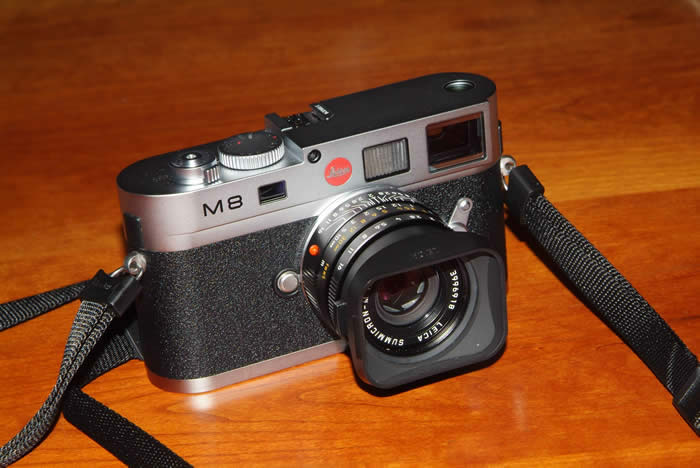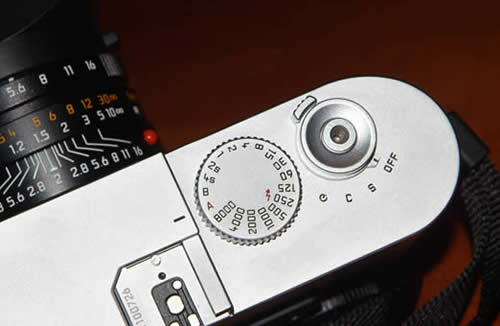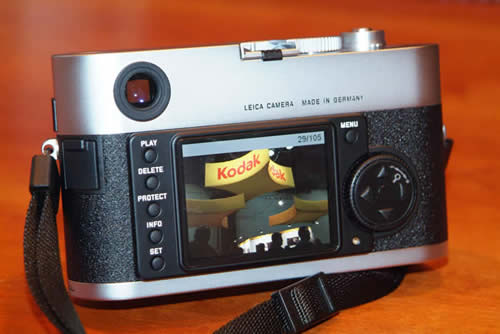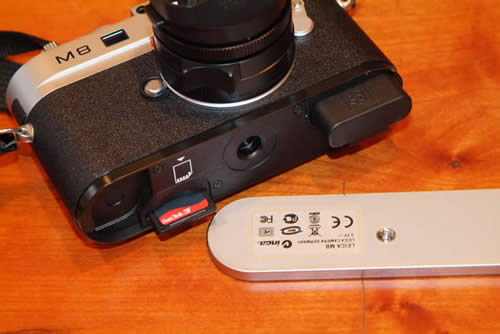Go Back to current Column
The Leica M8: When Dreams Come True
By Frank Van Riper
Photography columnist
With new digital cameras hitting the market seemingly every week, some might view Leica’s introduction of its long-awaited digital rangefinder camera, the M8, as just more of the same.
But they would be wrong.
Always appealing to a very limited, very sophisticated, very demanding market, Leica has spent the last several decades defying convention and ignoring the photo crowd. Its legendary rangefinder film cameras—the storied “M” series—became the favorite tool for photojournalists and documentarians who wanted to work quiet as a panther, sharp as a tack and dark as the night.
 |
| It looks like a Leica film camera, it works like a Leica film camera, but in fact it is Leica's phenomenal new DIGITAL rangefinder, the M8. (all photos by Frank Van Riper.) |
To be sure, Leica also appealed to the wider 35mm market with the introduction of its tank-like R-series single lens reflex cameras. These cameras found their niche among photographers who demanded the best in optical glass, but who also wanted the versatility and lens choice afforded by an SLR. (Simply put: there is no such thing as an ultra-telephoto lens for a rangefinder camera. When photographing a person with a Leica M6, for example, you either worked comparatively close to your subject or not at all.)
To dedicated M users (and I count myself among them) the camera’s almost mythical quiet can be as important as its phenomenally sharp lenses. I can think of few other sounds in photography as gentle and as reassuring as the delicate, nearly inaudible, click of a rangefinder Leica’s shutter.
Combine this quiet with the comparatively small size of a Leica M and you have the perfect camera for photographers like Gianni Berengo Gardin, Henri-Cartier Bresson or Garry Winogrand, who wanted their cameras to be extensions of themselves—not honking big machines that hung around their necks like pricey bling and that, worse, called attention to themselves with each cacophonous motor-driven exposure.
So the Leica rangefinder quickly established itself as the perfect tool for unobtrusive, on-the-fly shooting.
The only problem was that, as a whole new generation of digital-savvy and, more important, digital preferring, photographers came on board the mighty retro analog Leica M faced an inevitable loss of market among these mostly younger shooters.
The task facing Leica was not simply to come up with a digital camera—it has been doing that for years, most notably in the great Leica Digilux 2, as well as in the Lumix digital point and shoots (made in partnership with Panasonic of Japan.) No, the real problem was to come up with a digital camera that would appeal not only to younger (albeit well-heeled) serious photographers, but also to veteran M series shooters who longed to have a digital camera that mimicked virtually everything about the great M series film cameras: small size, easy, nearly intuitive, controls, manual rangefinder focusing (critical in low light) and, of course, legendary optics.
And in the phenomenal M8, Leica has created just such a camera.
 |
Controls for the M8 mirror those of a conventional camera, making
them very easy to master. (Note the absence of film rewind crank.) |
To the extent that it is humanly possible to achieve, Leica has fulfilled the fantasy of every analog Leica M shooter who has longed, even for just a moment, that his or her M6 or M7 or MP were digital. With a couple of exceptions and very minor changes, it is as if a German angel (think Bruno Ganz in ‘Wings of Desire’) had descended from the heavens, waved a wand (or a wing) and transformed the film camera in your hands into a digital one—with virtually no change in appearance and, more important, no change in image quality.
This is not to be taken likely. No other camera has built a reputation as Leica has on its amazing ease of use and range of control. Granted, this takes some getting used to—you, after all, are expected to adjust your camera, not the other way around. On the M’s there is no autofocus, precious little, if anything, in the way of automated controls, no zoom lenses. Still, using a Leica rangefinder, especially after becoming one with its quirks, is as close as you ever will come to seeing a picture and capturing it with barely a second thought.
One way Leica accomplishes this, of course, is through its phenomenal optical glass. In my case, that means my wonderful 35mm f.2 Summicron—the “money lens” of my 2-camera Leica system. At f.2, the lens can see in the dark, especially when twinned with a high-speed film like Ilford Delta 3200. With no reflex mirror on the camera to bounce up and down, I can hand-hold exposures of close to a quarter of a second (with either the film or digital M). When Leica decided that its superb film camera lenses must be compatible with its new digital incarnation it was a stroke of very practical marketing genius.
After all, no one--no one--expects Leica gear to be cheap. The 10MP Leica M8 body lists for roughly $4795. But at least those of us with analog Leicas can use our lenses on the new body with absolute confidence, not to mention identical sharpness.
In fairness, there have been some quibbles about this singular new camera. During the years of hype attending Leica’s long R&D into a digital rangefinder camera, there had been buzz that the M8 would offer a full-size 35mm sensor, similar to that offered on the highest end DSLRs.
 |
| Large LCD screen complements the simple array of controls. I have seen manuals for small flash units more complicated than the M8's. |
This was not to be, cost apparently being the deciding factor. As with most digital cameras today, the M8’s sensor measures 27mm x18mm, offering the familiar 1.33x crop. Also, when the M8 first came on the market, there were embarrassing problems with its color sensor, most centering on a proclivity to render magenta too vividly. These problems, Leica insists, have been fixed.
Some critics also have complained about the M8’s recording medium, the ever-more-popular SD card, rather than the older, larger CF card. I shared this unease with other cameras a few years ago but, now, frankly, I do not view it as anything close to a deal-breaker.
Oddly, the most persistent beef about this camera—the comparative insignificance of which only tending to point up how terrific the rest of the camera is—centers on the M8’s “noise.”
Not noise as in digital noise when the camera is set at a high ISO. (In fact, the camera’s image rendition is superb.) Rather, the noise refers to the actual sound the M8 makes when its electronic shutter is re-cocked. One thing that made the old film M’s so quiet was the fact that one’s thumb provided the power to re-cock the old camera’s cloth shutter curtain as it also advanced the film. The M8 has no shutter rewind dial (and obviously has no film to advance) so the re-cocking is done electronically—and that sound, though very low, is what is sticking on the craw of some Leica.
I guess I am not a real Leica fanatic. I didn’t find the sound disturbing.
 |
Baseplate of M8 comes off (as in its film predecessors.) Plate shields SD card (l.), as well as the proprietary rechargeable battery pack (r.)
|
What I did find—and what I liked bigtime—is how ruggedly the new M8 is built.
When I first held this camera, I was pleasantly surprised by its authoritative heft, bespeaking the same rugged metal body of the old M’s—a combination of magnesium alloy and brass. When I set the M8 next to my M6, it was as if it were looking in the mirror. Only a hair’s breadth wider that the traditional film body, the M8 could have been the M6’s twin—except for the missing film rewind dial.
So, on balance, I am thrilled that Leica has taken the time to get this important new camera right. For less traditional rangefinder photographers, the much less expensive Digilux 2 (5mp, list at less than $2,000) will fill the bill nicely.
But for those of us who love the look and feel—and quality—of the best camera on the planet, the M8 is a worthy addition to this distinguished family.
Frank Van Riper is Washington-based commercial and documentary photographer and author. His current book is Talking Photography (Allworth Press), a collection of his Washington Post and other photography writing over the past decade. He can be reached through his website www.GVRphoto.com
[Copyright Frank Van Riper. All Rights Reserved]
|